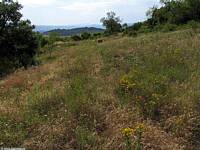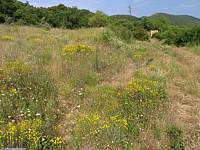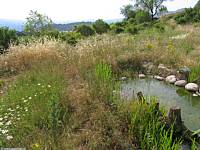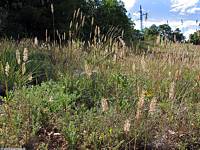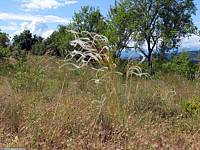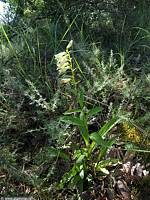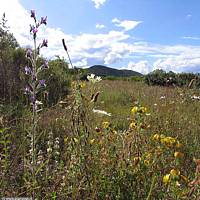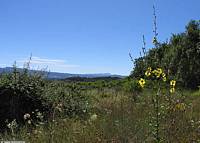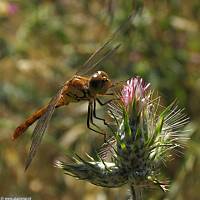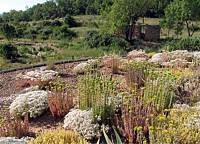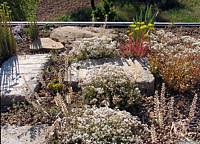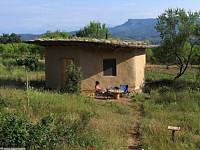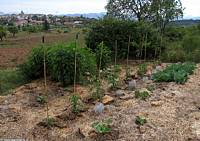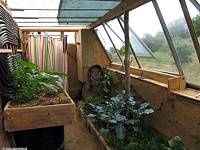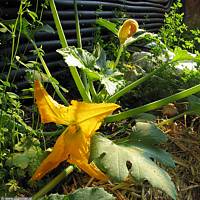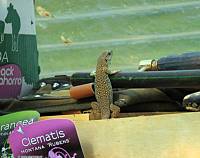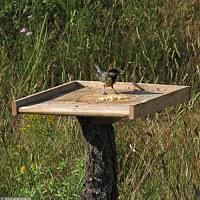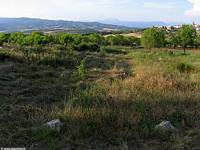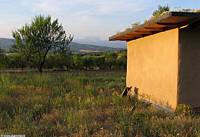|
|
Nature
Switched On
|
|
|
introduction |
2010 June 18 to July 2
Two pictures giving a nice overview, taken from the centre of the terrain and looking in opposite directions. The yellow colour in the picture on the left is from Santolina chamaecyparissus (and some Senecio jacobaea) while the white on the right is from Orlaya grandiflora, which is flowering abundantly for a month now.
Near the ponds there appears every year a spot with Wild oat grass (Avena fatua). It is a fearful weed in cereal fields but here it is quite decorative when the sun shines through it.
|
On the extreme left, an overview looking north-west, on the
left an overview looking south-east. |
|
At the back on the left, the golden white shining of Avena
fatua. 26 Jun 10:10 |
||
|
|
||
|
Koeleria pyramidata on the higher western terrace. 18 Jun 17:26 |
|
|
|
Introduced by us but still without offspring: Digitalis
lutea in the penumbra of the wood. 21 Jun 10:30 |
|
|
|
While some species have clearly been favoured by the abundant spring |
||
|
Verbascum blattaria
on the lowest terrace, looking south-east. 21 Jun 10:55 |
||
|
Carduus tenuiflorus has a very good year and appears on many new places.
|
||
|
A Sympetrum dragonfly on Carduus tenuiflorus
near the ponds. 21 Jun 10:48 |
||
|
The green roof is not exactly green these days. It is dominated by
the white flowers of Sedum album and Sedum
anglicum. The yellow Sedum acre has finished
flowering while the next species to flower is Sedum
reflexum (yellow) and then S. sediforme (white).
|
||
|
Looking south from the green roof, with the green house at the
back. 25 Jun 9:28 |
||
|
From left to right: Sedum sediforme (not
flowering), one rosette of Sempervivum tectorum, 3
groups of Sedum anglicum (white flowers, low),
one group of S. reflexum (yellow flowers) and one
group of S. album (white flowers, higher). 25 Jun 9:30 |
Looking north. |
|
|
2 Ivy plants fixed
temporarily with
cords to the north wall, near the most vulnerable zone of the
window. 26 Jun 9:31 |
||
|
The vegetable garden, looking north-west. The yellow and
white flowers are from the green fertilizers, resp. Lotus
corniculatus and Trifolium repens. |
Another pair of pictures, giving here an overview of the vegetable
garden. It is doing reasonably well, after a slow start in the
relatively cold and wet spring, but I am still in a stage of learning and experimenting.
The basic ideas are clear: no-tillage, green
fertilizers, straw mulch, crop rotation and no pesticides or
herbicides. No doubt
that
with these methods one cannot get record productions but that is not exactly
|
The vegetable garden,
looking east. The Jerusalum artichoke (Helianthus tuberosus) at the back has reached
already 1.5m. |
|
The greenhouse interior with Zucchini on the left and Broccoli
(blue-green) on the right. 28 Jun 11:07 |
This Zucchini is doing remarkably well in the shallow soil of
the wooden box in the greenhouse, probably thanks to the mulch of straw. |
|
|
This young Ocellated Lizard (Timon lepidus) is now a faithful tenant of the greenhouse. In the afternoon it can usually be found near the entrance, waiting for its prey.
|
||
|
Many times we find this Ocellated Lizard in this position near
the open side window, bathing in the morning sun and/or hunting. 2 Jul 8:59 |
||
|
The Great tits still appreciate some rinds of cheese which they mainly use to feed their youngsters. |
A Great tit on the bird feeder
in front of the house.
|
|
|
I started with the first haymaking of the season. Fairly early, as
the vegetation was still quite green and growing, b
|
||
|
I usually start with this area, quite infested by brambles which
might suffocate some shrubs of Portuguese oak and Barberry. 30 Jun 20:22 |
A pleasant evening sun over our īfront gardenī. |
|
|
introduction
|
|
